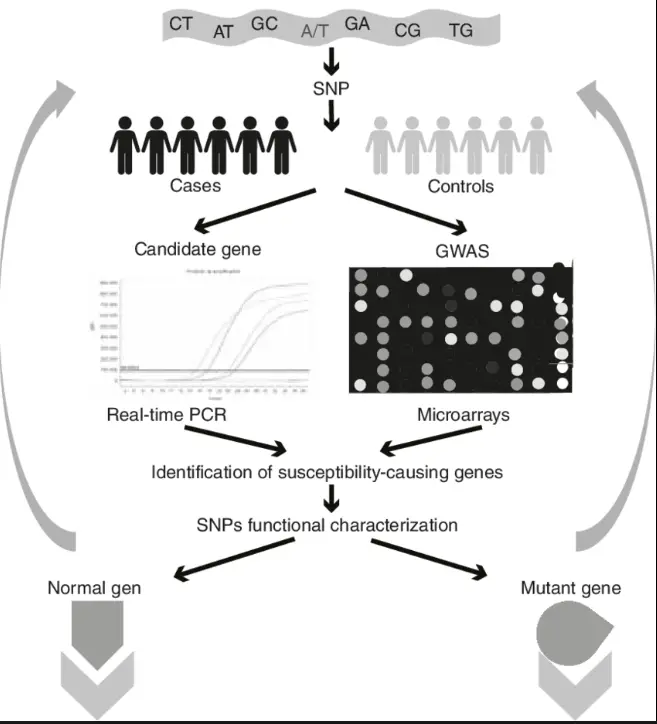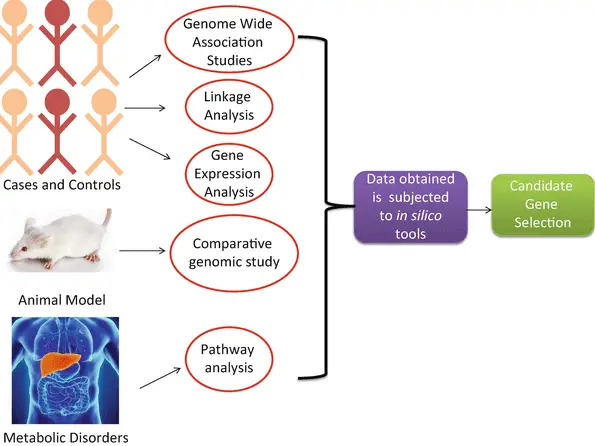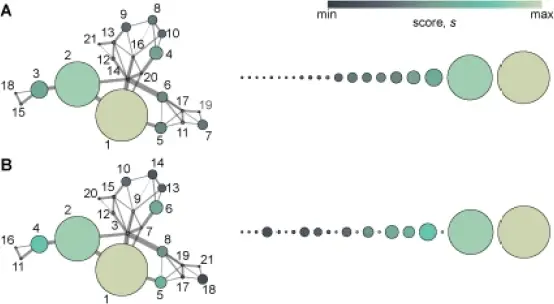Genetic research has dramatically transformed our understanding of health and disease, providing insights that were once thought impossible. Techniques for identifying genes associated with specific conditions have evolved, offering new ways to tackle genetic disorders. Among the methodologies employed, Candidate Gene Approach and Genome-Wide Association Studies (GWAS) stand out as pivotal strategies used by geneticists.
The Candidate Gene Approach focuses on investigating genes in a predefined region of interest known for their suspected involvement in disease, based on prior biological, physiological, or genetic evidence. In contrast, GWAS examines the entire genome, identifying genetic variations that occur more frequently in people with a particular disease than in people without the disease. This article highlights the differences between these two approaches, examining their scope, methodology, and impact on genetic research.
While both strategies aim to uncover genetic links to diseases, their approaches, applications, and implications vary widely. The Candidate Gene Approach offers a targeted exploration, whereas GWAS provides a broad, unbiased survey of genetic associations. Understanding these differences is crucial for researchers choosing the right method for their studies, as well as for anyone interested in the advances of genetic research.

Candidate Gene Approach
Definition and Explanation
The Candidate Gene Approach is a method used in genetic research focused on specific genes thought to be associated with a particular trait or disease. This approach investigates genes within a well-defined area of the genome, where there is prior evidence or suspicion of their involvement. The selection of these genes is usually based on existing biological, physiological, or biochemical data that suggests a potential link to the condition being studied.
Historical Context
The use of the Candidate Gene Approach dates back to the early days of molecular genetics, when the understanding of the genome was much more limited than it is today. Initially, this method was one of the few available options for researchers aiming to identify genetic contributions to complex diseases. Over time, as technological advances allowed for more comprehensive analyses, the approach has been both critiqued and complemented by newer methods, such as GWAS.
How It Works
The process of using the Candidate Gene Approach typically involves several key steps:
- Selection of Candidate Genes: Based on prior research and evidence linking certain genes to a disease.
- Genotyping: Individuals in a study are tested to identify variations in these specific genes.
- Association Testing: Statistical tests are used to compare genetic variants between groups (e.g., affected vs. unaffected) to see if certain variants are more frequently associated with the disease.
Key Features
- Targeted Approach: Focuses on specific areas of the genome.
- Prior Knowledge Required: Depends heavily on existing genetic and biological data.
- Faster and Less Resource-Intensive: Compared to genome-wide studies, it is often quicker and less costly due to the reduced number of genes analyzed.
Common Applications
The Candidate Gene Approach is commonly used in studies where there is strong prior evidence to support the involvement of specific genes. Examples include research into genetic disorders like cystic fibrosis or sickle cell anemia, where specific genetic mutations are known to play a direct role.
Genome-Wide Association Studies (GWAS)
Definition and Explanation
Genome-Wide Association Studies (GWAS) involve scanning the entire genome of many individuals to find genetic variations associated with a particular disease. Unlike the Candidate Gene Approach, GWAS does not start with a hypothesis about which genes are involved, making it an unbiased approach that can identify new genetic associations.
Development of GWAS
GWAS became feasible with the development of high-throughput genotyping technologies and the completion of the Human Genome Project. These advancements provided the necessary tools to rapidly assess large numbers of genetic variants across the genomes of many individuals.
Methodology
GWAS methodology typically follows these steps:
- Genotyping Large Cohorts: DNA from many participants is analyzed to identify millions of genetic variants.
- Statistical Analysis: Variants are tested for statistical associations with the disease across the cohort.
- Replication: Significant findings are tested in additional cohorts to validate the associations.
Key Features
- Unbiased Approach: Examines the entire genome without prior assumptions.
- High Statistical Power: Can detect associations with small effects.
- Large Scale: Requires large sample sizes and comprehensive data analysis.
Common Applications
GWAS is widely used in researching complex diseases such as diabetes, cancer, and heart disease, where the genetic basis is not well-defined and likely involves many different genes.
Comparing Approaches
Scope of Study
While the Candidate Gene Approach is limited to pre-selected regions of interest, GWAS covers the entire genome. This gives GWAS a broader scope, potentially uncovering unexpected genetic associations.
Accuracy and Reliability
GWAS typically offers greater statistical power due to larger sample sizes, which enhances the accuracy and reliability of its findings. However, the Candidate Gene Approach can provide more depth in specific areas of interest.
Cost Implications
The cost of GWAS has decreased significantly but remains higher than that of candidate gene studies, primarily due to the scale and the amount of data generated.
Time Considerations
GWAS requires extensive data processing and analysis, making it generally more time-consuming compared to the more focused Candidate Gene Approach.
Data Requirements
GWAS demands large datasets to achieve sufficient power and minimize false positives, whereas candidate gene studies can be conducted with smaller sample sizes but require strong prior biological evidence.

Advantages of Candidate Gene
Focused Research
The Candidate Gene Approach allows for targeted research where scientists concentrate on specific genes believed to be involved in a disease. This focus makes it possible to deeply investigate the functions and impacts of these genes, facilitating a thorough understanding of their roles in various conditions.
Lower Cost
Because it targets specific genes rather than scanning the entire genome, the Candidate Gene Approach is generally less expensive. This cost efficiency makes it accessible for smaller labs or studies with limited funding, allowing more researchers to contribute to genetic discoveries.
Speed of Results
With fewer genes to analyze, the Candidate Gene Approach can yield results faster than genome-wide studies. This rapid turnaround is especially beneficial in research areas where time is critical, such as in the development of treatments for rapidly progressing diseases.
Advantages of GWAS
Comprehensive Analysis
Genome-Wide Association Studies (GWAS) scan the entire genome, providing a comprehensive overview of all genetic variations. This method uncovers relationships between genes and traits that may be missed by more targeted approaches, offering a holistic view of the genetic underpinnings of diseases.
Higher Potential Discoveries
GWAS’s broad scope increases the potential to discover unexpected genetic associations with diseases. This ability to identify novel genes involved in health conditions is crucial for advancing our understanding of complex genetic interactions.
Statistical Power
The large sample sizes typically used in GWAS increase the statistical power of these studies, enhancing the reliability of their findings. This robust statistical approach helps in identifying true genetic associations with smaller effects, which might go unnoticed in smaller-scale studies.
Challenges and Limitations
Challenges of Candidate Gene Approach
- Limited Scope: Restricted to predefined genes, potentially overlooking other relevant genes.
- Prior Knowledge Dependency: Heavily reliant on existing data, which can bias the study towards well-studied genes, ignoring lesser-known but potentially crucial ones.
Limitations of GWAS
- Complex Data Management: Handling and analyzing the massive datasets generated can be challenging.
- Increased False Positives: Due to the vast number of comparisons made, there is a higher risk of false positive results, necessitating stringent correction methods.
Addressing Biases in Both Approaches
Efforts to minimize biases include:
- Enhanced Study Designs: Utilizing mixed approaches or validating findings through multiple methodologies.
- Replication Studies: Conducting follow-up studies to confirm initial findings.
- Cross-disciplinary Collaborations: Integrating knowledge from various fields to improve study designs and interpretation of data.
Impact on Research
Contributions to Medical Research
Both the Candidate Gene Approach and GWAS have significantly contributed to medical research, providing insights that have led to improved diagnostic methods, better understanding of disease mechanisms, and the development of targeted therapies. These approaches have opened new avenues for personalized medicine, where treatments can be tailored to the genetic profile of individual patients.
Influence on Drug Development
The identification of disease-associated genes has directly influenced drug development, leading to the creation of drugs that target specific genetic pathways involved in diseases. This targeted drug development is crucial for conditions that have a strong genetic component, such as certain types of cancer and cardiovascular diseases.
Future Prospects in Genetic Research
The future of genetic research looks promising, with continuous improvements in both candidate gene studies and GWAS. Innovations in technology and methodologies are expected to refine these approaches further, enhancing their accuracy and reducing costs. As we gain a deeper understanding of genetic influences on health, the integration of genetic data into routine medical practice could transform healthcare, emphasizing prevention and precision in treatment strategies.
FAQs
What is a Candidate Gene Approach?
The Candidate Gene Approach is a method in genetic research where scientists focus on genes that are already suspected to have a connection to a specific disease. This approach relies heavily on existing knowledge about biological and genetic interactions.
How does GWAS differ from other genetic studies?
Genome-Wide Association Studies (GWAS) differ from other genetic approaches by analyzing the entire genome in a non-targeted way. This allows researchers to identify genetic variations linked to diseases without prior knowledge of genetic relationships.
Why is GWAS considered more comprehensive?
GWAS is considered more comprehensive because it examines all genetic variations across the genome, which helps in identifying new genetic markers that were not previously associated with any disease. This method increases the likelihood of discovering novel genetic associations.
What are the limitations of the Candidate Gene Approach?
The main limitation of the Candidate Gene Approach is its reliance on prior knowledge. This can lead to a bias where only certain genes are examined, potentially overlooking other significant genes involved in a disease.
When should researchers choose GWAS over Candidate Gene?
Researchers should consider choosing GWAS over the Candidate Gene Approach when they require a broad and unbiased analysis of the genome. GWAS is particularly useful in cases where the genetic basis of a disease is not well understood.
Conclusion
The evolution of genetic research methodologies such as the Candidate Gene Approach and GWAS has greatly enhanced our understanding of the complex interactions within our DNA that lead to various health conditions. Each approach has its strengths and limitations, but together, they provide a comprehensive toolkit for deciphering the genetic foundations of disease.
As we continue to advance in our genetic research capabilities, the choice between these two methodologies will increasingly depend on the specific objectives and requirements of the study. Future advancements may well integrate the strengths of both approaches, leading to more effective and precise genetic research strategies that can better serve the needs of medical science and patient care.

